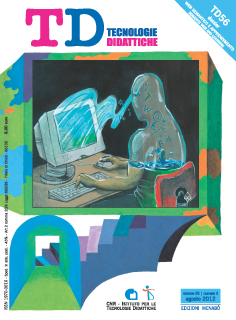Semantic Web a supporto dell'ambiente personale di lavoro e apprendimento
Contenuto principale dell'articolo
Abstract
Dettagli dell'articolo
Gli autori che pubblicano su questa rivista accettano le seguenti condizioni:
- Gli autori mantengono i diritti sulla loro opera e cedono alla rivista il diritto di prima pubblicazione dell'opera, contemporaneamente licenziata sotto una Licenza Creative Commons CC BY 4.0 Attribution 4.0 International License.
- Gli autori possono aderire ad altri accordi di licenza non esclusiva per la distribuzione della versione dell'opera pubblicata (es. depositarla in un archivio istituzionale o pubblicarla in una monografia), a patto di indicare che la prima pubblicazione è avvenuta su questa rivista.
- Gli autori possono diffondere la loro opera online (es. in repository istituzionali o nel loro sito web) prima e durante il processo di submission, poiché può portare a scambi produttivi e aumentare le citazioni dell'opera pubblicata (Vedi The effect of Open Access).
Riferimenti bibliografici
Allemang D., Hendler J. (2008). Semantic web for the working ontologist : modeling in RDF, RDFS and OWL. Waltham, MaA, USA: Morgan Kaufmann Publishers/Elsevier.
Attwell G., Costa C. (2008). Integrating personal learning and working environments. Beyond Current Horizons. Working and Employment Challenge. Institute for Employment Research, University of Warwick paper series.
Billett S. (2001). Learning through work: workplace affordances and individual engagement. Journal of Workplace Learning. 13 (5), pp. 209-214.
Brown J., Collins A., Duguid P. (1989). Situated cognition and the culture of learning. Educational Researcher,. 18 (1), pp. 32-42.
Calvani A. (2007). Fondamenti di didattica. Teoria e prassi dei dispositivi formativi. Carocci, Roma.
Capuano N., Miranda S., Orciuoli F. (2009). IWT: a semantic web-based educational system. In G. Adorni, M. Coccoli (eds.). Proceedings of IV Workshop of the Working Group on Artificial Intelligence & E-Learning (Reggio Emilia, 9-12 dicembre 2009). AI*IA -, Associazione Italiana per l’Intelligenza Artificiale. http://www.capuano.biz/papers/AIxIA_2009.pdf (ultima consultazione 06/04/2012).
Dong A., Zhang R., Kolari P., Bai J., Diaz F., Chang Y., Zheng Z., Zha H. (2010). Time is of the essence: improving recency ranking using Twitter data. In WWW’ 10: Proceedings of the 19th international conference on World wide web (Raleigh, NC, 26-30 aprile 2010). New York, N.Y.: ACM, pp. 331- 340, http://www.ra.ethz.ch/CDStore/www2010/www/p331.pdf (ultima consultazione 10/04/2012).
Frauenfelder E., Santoianni F. (eds.) (2006). E-Learning. Teorie dell’apprendimento e modelli della conoscenza. Milano: Guerini Editore.
Gruber T.R. (2008). Collective knowledge systems: where the social web meets the semantic web. Web Semantics: Science, Services and Agents on the World Wide Web. 6 (1), pp. 4-13.
Gruber T.R. (1993) A translation approach to portable ontology specifications. Knowledge Acquisition. 5 (2), pp. 199-220.
Kew C. (2006). TENCompetence: lifelong learning and competence development. In W. Nejdl, K. Tochtermann (eds.). Innovative Approaches for Learning and Knowledge Sharing: First European Conference on Technology Enhanced Learning, EC-TEL 2006 (Creta, Grecia, 1-4 Ottobre, 2006). Lecture Notes in Computer Science, Vol. , 4227,. Springer 2006, pp. 621- 627, http://dspace.ou.nl/bitstream/1820/832/1/42270621.pdf (ultima consultazione 10/04/2012).
Knuf J. (2000). Benchmarking the lean enterprise: organizational learning at work. Journal of Management in Engineering. 16 (4), pp. 58-71.
Lindstaedt S., Mayer H. (2006). A storyboard of the APOSDLE vision. In W. Nejdl, K. Tochtermann (eds.). Innovative Approaches for Learning and Knowledge Sharing: First European Conference on Technology Enhanced Learning, EC-TEL 2006 (Creta, Grecia, 1-4 Ottobre, 2006). Lecture Notes in Computer Science, Vol. 4227,. Springer 2006, pp. pp. 628-633.
Marquardt M. J. (2004). Optimizing the Power of Action Learning. Palo Alto: Davies-Black Publishing.
Nonaka I., Takeuchi H. (1995). The knowledge-creating company: how Japanese companies create the dynamics of innovation. Oxford, UK: Oxford University Press.
Ohliger, J., McCarthy C. (1971). Lifelong Learning or Lifelong Schooling? A Tentative View of the Ideas of Ivan Illich with a Quotational Bibliography. Syracuse, N.Y.: Syracuse University.
Rivoltella P.C. (2010). Ontologia della comunicazione educativa. Metodo, ricerca, formazione. Milano: Vita&Pensiero.
Schmidt A., Kunzmann C. (2006). Towards a human resource development ontology for combining competence management and technology-enhanced workplace learning. In Z. Tari (ed.). On The Move to Meaningful Internet Systems 2006: OTM 2006 Workshops. Part I. 1st Workshop on Ontology Content and Evaluation in Enterprise. Lecture Notes in Computer Science, Vol., 4278,. Springer, pp.1078-1087.
Straka, G. A. (2005). Informal learning: genealogy, concepts, antagonisms and questions. In K. Künzel (ed.). International Yearbook of Adult Education. Köln: Böhlau Verlag, pp. 27-45..
Wenger E. (1998). Communities of Practice. Cambridge University Press.
Zenkl L., Mayr E., Pircher R., Risku H., (2009). Contextualization of situated e-learning and knowledge transfer in organizations. In K. Hinkelmann, H. Wache (eds.),. Wissensmanagement’ 2009 -, Fifth Conference Professional Knowledge Management: Experiences and Visions, (Solothurn, Switzerland, Mmarchzo 25-27, 2009, Solothurn, Switzerland,), pp.42-51.

